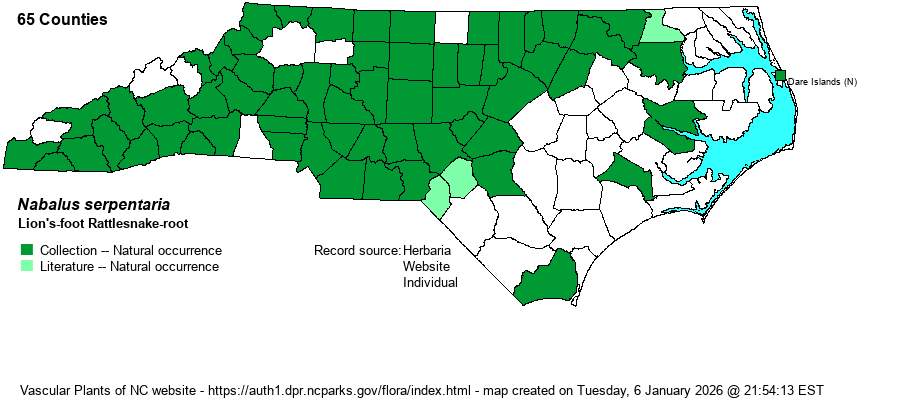| Author | (Pursh) Hooker | |
| Distribution | Low-mid elevation Mountains, Piedmont, and scattered locations on the Coastal Plain with Piedmont-like soils and habitats. On the Outer Banks, found at Kitty Hawk Woods and Nags Head Woods. Absent from the Sandhills proper and much of the Coastal Plain.
MA to OH and KY, south to northern FL and MS. | |
| Abundance | Fairly common in the Piedmont; infrequent to fairly common in the Mountains, but rare in the western and central Coastal Plain, plus a few Outer Banks forests. | |
| Habitat | Dry to mesic pine-oak-hickory woodlands and forests, openings in these habitats, forest margins, maritime forests. | |
| Phenology | Flowering and fruiting August-October. | |
| Identification | Rattlesnake-roots are characterized by nodding heads of ray florets only, alternate leaves that are roughly triangular and irregularly lobed and/or toothed, and milky juice. Lion's-foot Rattlesnake-root grows 2-7 feet tall and has tan-colored pappus (feathery hairs attached to seeds) and pale yellow florets. From N. altissimus it differs in its leaves relatively thick-textured (vs. thin) and florets more than 8 per head (vs. less than 8). From N. trifoliatus it differs in the sparse to moderate hairs on the involucre bracts (vs. glabrate in the latter species). Also, its lower leaves have generally rounded sinuses and lobes (vs. palmately 3-5 lobed and with angular lobes and sinuses in most other Nabalus species). Biologists need to be familiar with the thick leaves that have rounded lobes and sinuses, as many such leaves will be seen in a forest without an inflorescence. | |
| Taxonomic Comments | None, though it was named as Prenanthes serpentaria in previous references. Weakley (2022) explained the change from serpentarius to serpentaria.
| |
| Other Common Name(s) | Gall-of-the-earth, Lion's-foot, Cankerweed | |
| State Rank | S5 | |
| Global Rank | G5 | |
| State Status | | |
| US Status | | |
| USACE-agcp | | |
| USACE-emp | | |

